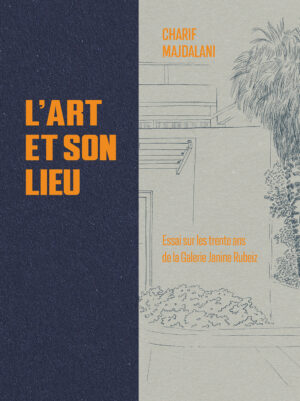

L'Art et son Lieu
Overview
Text: Charif Majdalani
Anthologie visuelle: Gregory Buchakjian
Il y a trente ans naissait la galerie Janine Rubeiz, sous la férule de Nadine Begdache et à partir de l’héritage laissé par l’une des grandes figures de la culture libanaise qui donnera son nom à la galerie. Trente ans après, et à l’occasion de cet anniversaire, Charif Majdalani retrace l’histoire de ce lieu qui, durant trois décennies, aura marqué la scène culturelle et artistique de Beyrouth. Ce faisant, l’écrivain relate succinctement une part de l’histoire de l’art moderne et contemporain au Liban et de ses espaces d’expositions, au sein desquels Nadine Begdache et la g alerie Janine Rubeiz ont occupé une place prépondérante. Une riche anthologie visuelle établie par Gregory Buchakjian accompagne et dialogue avec le texte.
About the Authors
Charif Majdalani
Charif MAJDALANI (b. 1960, Lebanon) is a Lebanese French-speaking novelist. After studying at the Lycée Français in Lebanon, he went on to receive his doctoral degree with a thesis on Antonin Artaud from the University of Provence in 1993, before returning to Lebanon. He was a professor at the Université Saint-Joseph in Beirut, as well as the dean of the department of French literature from 1999 to 2008. A member of the editorial board of l'Orient Littéraire and president of the International House of Writers in Beirut, he published seven novels at Editions du Seuil, including Histoire de la Grande Maison (2005), Caravansérail (2007 - Tropics Prize and François Mauriac Prize of the Académie Française), Villa des Femmes (2015 - Jean Giono Prize) and the Emperor on Foot (2017). At Actes Sud, he published Beyrouth 2020, journal d'un effondrement, (winner of the Special Jury Prize for the Femina) and Last Oasis (2021).
Gregory Buchakjian
Gregory Buchakjian is an art historian and interdisciplinary visual artist. He lives and works in Beirut where he was born in 1971. PhD graduate at Sorbonne Université, he is director of the School of Visual Arts and Associate Professor at Académie Libanaise des Beaux-Arts (ALBA). Buchakjian’s practice is based on narrative, archive and archeology. Investigating on urban turmoil, dereliction and heritage engendered his PhD dissertation, the subsequent book, Abandoned Dwellings, A History of Beirut (Beirut, Kaph Books: 2018, Valerie Cachard, ed.) and the solo exhibitions Abandoned Dwellings, Display of Systems (Beirut, Sursock Museum, 2018 curated by Karina El Helou) and Abandoned Dwellings of Beirut (Brussels, Villa Empain, 2019). In 2018, he was showcased in the first national pavilion of Lebanon at the Venice Architecture Biennale and he contributed to the Works on Paper accompanying Karina El Helou's Cycles of Collapsing Progress exhibition in Oscar Nimeyer's Tripoli International Fair. In 2019 he conceived the installation Where do filmmakers go? for the 2nd Alba Cinema encounters, "Filming in Times of War", which he co-organized. In 2021, he created with Valérie Cachard and Sary Moussa the video Agenda 1979 at the invitation of the Opera National du Rhin, and the installation Hercules and Omphale for the exhibition How will it end? (Villa Empain, Brussels, in partnership with Centre Pompidou), based on a painting that was damaged by the blast of the 4th of August 2020 he attributed to Artemisia Gentileschi. In 2022, he premiered at Fotofocus Biennial Cincinnati his long-term Record of an Ordinary Life and intervened with Temporary art Platform in the Roman Temple of Hosn Niha. Member of the advisory committee of the Saradar Collection, he took part in many juries including Sursock Museum Salon d’Automne (2009), Boghossian Prize (2012), Beirut Art Center’s Exposure (2013), Beirut Art Residency (2017) and Arab Documentary Photography Program (2019).
Technical Details
- Publication Date:
- Monday, January 8, 2024
- Language:
- French
- Format:
- Softcover with flap
- Dimensions:
- 24 x 18 cm
- Weight:
- 0.5 kg
- ISBN:
- 978-614-8035-60-9
- Number of Pages:
- 214
- Publisher:
- Kaph Books
- Categories:
- Arts